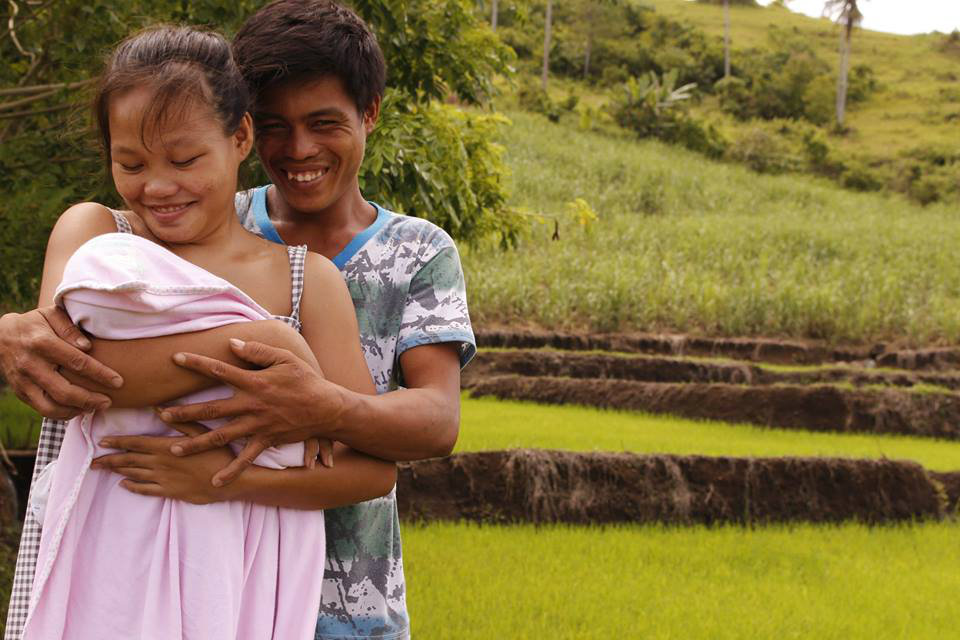 MANILA, Philippines – As a little girl growing up in Capiz, Western Visayas, Jonamae, 17, loved putting make-up on her friends. She thought of them as dolls that she never had. She dreamed of working in a beauty parlor some day, dolling up real people.
MANILA, Philippines – As a little girl growing up in Capiz, Western Visayas, Jonamae, 17, loved putting make-up on her friends. She thought of them as dolls that she never had. She dreamed of working in a beauty parlor some day, dolling up real people.
When he was a small boy, Christian, 21, dreamed of studying marine engineering so he could become a seafarer when he grew up. He longed to see the world outside of his village.
But times were hard for both their families – the reality of poverty did not offer an opportunity. Their dreams remained a wish that at times turned into regret.
The two met while working as farmhands on a hacienda, tilling and harvesting sugarcane. It was a short courtship and within a year, the young couple welcomed baby CJ (named after Christian and Jonamae) into their life.
Jonamae wants to have just one child. She says this while holding baby CJ in her arms and rocking her softly, every so often touching her lips to her baby’s forehead. Christian says he wants to have two children, one girl and hopefully, one boy.
The two have not really agreed on how big (or how small) they want their family to be. Actually, they have not talked much at all about family planning. It is a discussion that gets lost in the everyday demands of working at jobs that barely allow them to make ends meet while caring for their newborn.
They, like a lot of rural couples, get their information from Barangay Health Workers (BHW), women who also live in their community and are trained by the Department of Health (DOH) and the NGOs on maternal health care. There is at least one BHW assigned to each barangay, more if the barangay is a big one.
Door-to-door
BHWs bridge community families, both far and near, to health care providers. They go door-to-door, family-to-family reminding pregnant women to get pre-natal check-ups, and teaching those who have just given birth how to space their pregnancies. Occasionally, they may assist a mid-wife during a home birth. BHWs are walking talking maternity clinics and are crucial to the delivery of reproductive health care services to couples like Jonamae and Christian. (READ: BHWs on the mountain top)

“Barangay health workers play a critical role in the delivery of health care services. They are members of the community, so they are immersed. They know the (health) needs and wants of their community best,” said Dr Anabelle Fajardo, executive director of the Family Planning Organization of the Philippines (FPOP).
The way that BHWs bring health care systems closer to the communities is more than just a matter of logistics.
“The health care system is alien to women in the communities. There is a barrier that BHWs help overcome. They speak the language of the community and understand the context of poverty and gender,” said Dr Junice Melgar, executive director of the Likhaan Center for Women’s Health.
According to Melgar, this is a context that not many health care providers do not know when a patient consults.
“They speak in English, use medical terms, it is alienating. It is the barangay health worker whom women trust, the one they can speak to at their level,” Melgard explained.
Some studies on equity in health care have shown “that negative and judgmental attitudes towards poor patients in general and women in particular may prevent women in some cultures from using health care facilities. Women in these settings are not always treated with respect by health care providers.”
Bringing healthcare to them
While it may not the be the norm for many women to go to their nearest clinic for a check-up, BHWs step up and bring the healthcare system to them. Through casual conversation, they inject information about family planning and birth spacing, the usual question of “Kamusta ka na? (How are you?)" turns into a discussion about how the kids are doing.
And because of the training they receive from the DOH and other healthcare organizations, BHWs can give advice on childcare like vaccination, de-worming, and even the common cold.
For reasons of the heart, it is the barangay health worker that women trust with the health of their families.
Humble health care provider
Lina Bacalando has been a barangay health worker for Likhaan for 20 years now, taking care of areas in Manila (Vitas and Tondo) and Malabon. Anywhere she goes in these communities, even among little children, "Ate Lina" is known as "ang kanilang munting manggamot at guro (their little, humble health care provider and teacher)."
"Ang pinakamasaya ay makita mo ang mga kababaihang nakapagtrabaho na, nakakasuklay na dahil may panahon na sila para sa sarili nila at natuto na silang ipaglaban ang kanilang karapatan sa RH at Family Planning," said Bacalando. (Nothing could be happier than seeing women who are able to go to work, or even comb their hair, now that they found time for themselves and learned to fight for their RH and family planning rights.]
A documentary film entitled "Silungan" (Shelter) has been produced featuring the work that Bacalando has done in her years as a BHW.
“We health care providers would be able to do the work we do without our barangay health care workers,” said Melgar. – Rappler.com
Ana P. Santos is a former banker turned public health journalist focusing on women’s issues and sexual health rights. It’s a mouthful and for the most part, she’s simply referred to as a “sex columnist.” She blogs (and rants) at www.sexandsensibilities.com and tweets @iamAnaSantos.